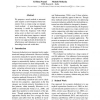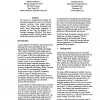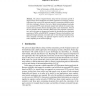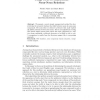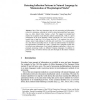AAAI
2012
12 years 6 months ago
2012
Entity Recognition (ER) is a key component of relation extraction systems and many other natural-language processing applications. Unfortunately, most ER systems are restricted to...
WSDM
2012
ACM
12 years 11 months ago
2012
ACM
One popular form of semantic search observed in several modern search engines is to recognize query patterns that trigger instant answers or domain-specific search, producing sem...
ACL
2010
14 years 2 months ago
2010
We propose a novel method to automatically acquire a term-frequency-based taxonomy from a corpus using an unsupervised method. A term-frequency-based taxonomy is useful for applic...
ANLP
2000
14 years 5 months ago
2000
We present an unsupervised method for detecting grammatical errors by inferring negative evidence from edited textual corpora. The system was developed and tested using essay-leng...
ERCIMDL
2006
Springer
14 years 7 months ago
2006
Springer
The advent of digital libraries along with the tremendous growth of digital content call for distributed and scalable approaches for managing vast data collections. Peer-to-peer (P...
CICLING
2006
Springer
14 years 7 months ago
2006
Springer
Previous work by Pedersen, Purandare and Kulkarni (2005) has resulted in an unsupervised method of name discrimination that represents the context in which an ambiguous name occurs...
AIMSA
2006
Springer
14 years 7 months ago
2006
Springer
Abstract. We present a novel, simple, unsupervised method for characterizing the semantic relations that hold between nouns in noun-noun compounds. The main idea is to discover pre...
CIARP
2004
Springer
14 years 9 months ago
2004
Springer
One of the most important steps in text processing and information retrieval is stemming—reducing of words to stems expressing their base meaning, e.g., bake, baked, bakes, bakin...
CVPR
2007
IEEE
15 years 6 months ago
2007
IEEE
We describe an unsupervised method to segment objects detected in images using a novel variant of an interest point template, which is very efficient to train and evaluate. Once a...

